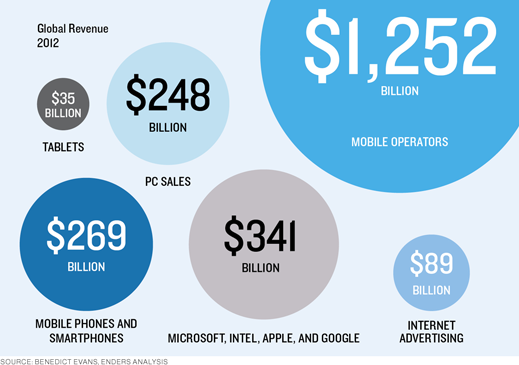The Numbers in the Microsoft-Nokia Deal Are Telling
The price of the deal stood out the most in today’s news that Microsoft is spending 5.4 billion euros ($7.2 billion) to buy Nokia’s devices business, license its patents, and provide financing to the company. Because just a day earlier, Verizon announced it would pay Vodafone $130 billion for the 45 percent of Verizon Wireless that it didn’t already own. In other words, although Nokia touches many more lives (it probably will sell more than 200 million phones this year, while Verizon Wireless has 100 million customers in the U.S.), it’s worth about 1/40th of Verizon Wireless.
It’s a reminder that in the smartphone craze of the past few years, the lion’s share of the revenue has flowed not to app developers or handset makers, but to wireless network operators like Verizon Wireless, whose business is protected by high barriers to entry and who are less subject to the fickleness of consumer tastes. That was captured neatly in the chart below, from our March Business Report on Making Money in Mobile (see “Smartphones Are Eating the World”).

Even Sprint Nextel, which ranks a distant No. 3 among wireless network operators in the U.S., is being sold for three times what Microsoft is paying for the Nokia assets. Of course, as Apple shows, there is a lot of money to be made in making and selling handsets. But in Nokia’s case the battle was much harder, if not impossible, because it didn’t sell phones on the dominant platforms, iOS and Android, which account for 93 percent of the market.
Keep Reading
Most Popular
Large language models can do jaw-dropping things. But nobody knows exactly why.
And that's a problem. Figuring it out is one of the biggest scientific puzzles of our time and a crucial step towards controlling more powerful future models.
The problem with plug-in hybrids? Their drivers.
Plug-in hybrids are often sold as a transition to EVs, but new data from Europe shows we’re still underestimating the emissions they produce.
Google DeepMind’s new generative model makes Super Mario–like games from scratch
Genie learns how to control games by watching hours and hours of video. It could help train next-gen robots too.
How scientists traced a mysterious covid case back to six toilets
When wastewater surveillance turns into a hunt for a single infected individual, the ethics get tricky.
Stay connected
Get the latest updates from
MIT Technology Review
Discover special offers, top stories, upcoming events, and more.